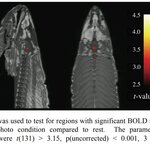Neuroscience

A new study reports abnormalities in functional neural networks of dogs diagnosed with anxiety. Compared with healthy dogs, those with anxiety exhibit stronger connections between the amygdala and other regions of the anxiety network.
Animal models of anxiety can benefit both veterinary and eventually point to human medicine. However, the many different aspects of anxiety cannot all be studied effectively in the same animal model. Rodents are cheap and therefore often studied, but this new study takes advantage of the larger brains and bigger cortex found in dogs to characterize neural…

For decades, functional magnetic resonance imaging, looking at changes in the brain's blood oxygen, has over-promised and under-delivered, which made it a punching bag in the science community. People in the field tried to claim changes in pretty pictures meant more neurons working and suggested that meant X part of the brain controls Y behavior. It was never a valid link.
By 2009, a paper even showed how easy it was to use a dead fish to make interpretations about emotion, and achieve the sought-after "statistical significance." Gone was the promise of clinical information that might…

Autism is a neurodevelopmental disorder that affects communication, social interaction, and behavior, with a prevalence of one in 54 children in the United States. While there is no cure for autism, there are several therapies that can help children with autism improve their communication, social skills, and behavior. However, autism is often discussed in ways that suggest that autistic people are subjects who cannot actively participate in their own treatment, and this has led to autism treatments that do not benefit autistic people being promoted.What is Autism?Autism, or autism spectrum…

Migraine is a common condition, involving a severe recurring headache but sometimes nausea, weakness and light sensitivity as well. According to the American Migraine Foundation, over 37 million people in the U.S. report being affected by migraine, though only 148 million people worldwide report suffering from it.
Perivascular spaces are fluid-filled spaces surrounding blood vessels in the brain. They are most commonly located in the basal ganglia and white matter of the cerebrum, and along the optic tract. Perivascular spaces are affected by several factors, including abnormalities at the…

Virtual Reality devices are advertised everywhere but have as much uptake as USDA nutrition guidelines or 3-D televisions. One reason is that it's a lot of money for something you can use for 20 minutes without fatigue. Another is VR sickness, a type of motion sickness which comes from users seeing “motion” through their headsets without actually moving. The symptoms include headaches, nausea, and sometimes vomiting.
A new methodology hopes to help ease that. The collaboration was able to let users on Segways share not only what they see but also the feeling of acceleration as they move…

Neuroscience is still in its infancy, despite claims by people using fMRI to suggest links between lots of things, but a few things are established, like that fear 'resides' in the amygdala.
Linking that same part of the brain to obesity in mice, and therefore humans, in a new paper warrants more skepticism. Mice are, as famously stated when science was science, not tiny people. We do have things in common with mice, just like we share 60% of our DNA with bananas, but no one suggests their study on bananas has 'implications' for humans the way every trial lawyer running a grift and wanting to…

It's become postmodernism to state that there isn't much difference between women and men but that is by people who conflate gender with biology. Scientifically, there are vast differences, to such an extent that there is worry about clinical trials because not enough women are included.
Some things that are considered potential stereotypes, men are slightly better at math, women are better at language, also get critical examination regarding differences in cognitive abilities and what the underlying brain mechanisms might be.
Yet actual findings about beliefs like that when naming…

The Multicentre Epilepsy Lesion Detection project (MELD) used over 1,000 patient MRI scans from 22 global epilepsy centers to develop an algorithm which provides reports of where abnormalities are in cases of drug-resistant focal cortical dysplasia (FCD) – a leading cause of epilepsy.
Around 1 percent of the world’s population have the serious neurological condition epilepsy, that is characterized by frequent seizures. While drugs treatments are available for the majority of people with epilepsy, 20 to 30 percent do not respond to medications.
The ability to detect subtle brain…

We often think of babies as blank canvases with little ability to learn during the first few weeks of life. But babies actually start processing language and speech incredibly early. Even while in the womb, they learn to discern voices, along with some speech sounds. At birth, they already prefer speech sounds over other types of non-language sounds.
But exactly how the baby brain learns to process complex language sounds is still a bit of a mystery. In our recent study, published in Nature Human Behaviour, we uncovered details of this mindbogglingly speedy learning process – starting in the…

Why do most people eat dessert after dinner but not before? Culture, or the brain?
The prevailing belief is that the body often needs protein so only after that is obtained are carbohydrates 'craved', to add to the body’s fat stores. Yet it is not so simple and a new study combines effects to see how the brain's parallel internal states guide behavior.
An obvious example is being pregnant. 'Pregnancy brain' is real, so to investigate how internal states shape behavior, the team focused on a relatively poorly understood region of the fruit-fly brain called SEZ (the subesophageal zone).…